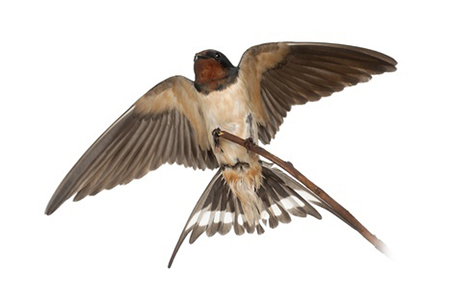
Swallows
CLIFF SWALLOW: (Petrochelidon pyrrhonota)
Description:
Cliff swallows are about 5 to 6 inches long. When not in their nest, they are constantly searching for food. Their long pointed wings identify them as they dart through the sky. They are pale, orange-brown rump, white forehead, dark rust-colored throat, and steel blue crown back and wings. Normally, swallows are not seen on the ground except when collecting mud for their gourd-shaped nests.
Biology:
Cliff Swallows migrate home every spring. They feed on insects and spend most of their time in the air catching flies, gnats, beetles, and mosquitoes. These swallows build mud nests attached to eves and overhangs of buildings and other structures. This is particularly true when Cliff Swallows build a colony where several nesting pairs build dozens of mud nests. The nests are cemented to the underside of an overhang of buildings, bridges, or other vertical surfaces. Once they start, their habit is to form a dense cluster or colony of gourd-shaped mud nests.
Did You Know?
Because of the colonial lifestyle, Cliff swallows have developed many complex behaviors. For example, if a cliff swallow has trouble finding food, it will watch its neighbors and follow one to food. They also practice brood parasitism, with females laying eggs in other females' nests and moving eggs from their own nests to others'.
Impact:
A colony of Cliff Swallows nesting on a commercial building can become a major nuisance adding to the cost of maintenance and sanitation. Their mud nests and droppings can destroy stucco and other surfaces, defacing the appearance of a building. Cliff swallows are colonial so the number of nesting birds will increase significantly yearly. Their droppings also present a potential health hazard. Swallow nests contain mites, insects and swallow bugs, known more commonly as bed bugs, that can enter buildings. The decaying mud nests eventually fall to the ground and can cause injury, particularly if the nests are above a door or walkway.
Solutions:
Issues with swallows should be managed as soon as they appear and are identified. They are best managed by nest removal and exclusion techniques. Their mud can be washed off or removed before nesting, but this must be done quickly upon arrival. Netting can provide an effective physical barrier between the birds and the nest site. Once the swallows have completed their nest, they immediately lay their eggs and come under the protection of the Migratory Bird Treaty Act of 1918. Swallows are then protected by State and Federal regulations, as migratory birds. During nesting, a permit authorizing removal can only be issued by the U.S. Fish and Wildlife Service, and only if it can be justified by strong, compelling reasons such as health or hazard. The minimum fine for disturbing a nest under the protection of State and Federal law is $25,000.
Additional Links:
http://www.ipm.ucdavis.edu/PMG/PESTNOTES/pn7482.html
